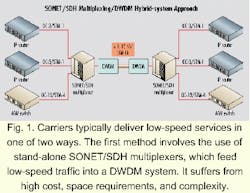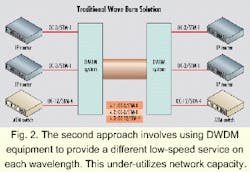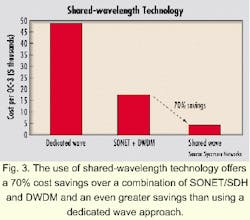Component technology advances ease transition to data networking
The ability to integrate multiple functions on the same line card will accelerate the use of optical technology for low-speed data service delivery.
A quiet revolution is occurring in the optical network. It wasn't long ago that the biggest challenge within the optical network was to solve optics-related issues. In other words, it was a game of physics. Then a dramatic change happened: The International Telecommunications Union standardized a wavelength grid. Now, with an entirely new industry of optical-component suppliers, high-quality lasers, filters, and amplifiers can be acquired from numerous sources and suppliers. At the same time, there have been rapid advancements in commercially available VLSI components--both in reduced size, power, and increased functionality.
As a result of these changes, it is no longer a "physics game" but a "systems and software game." With rapid innovation occurring almost daily with new optical and electrical components, success will be determined by how quickly new technology can be assimilated, productized, and brought to market.
This trend will have a significant effect on how service providers meet their biggest challenge--how to scale their networks to support the explosion in data traffic. With the unabated growth of the data network, service bandwidth needs have increased from DS-0/DS-1/DS-3 to OC-3/OC-12/OC-48. The optical network has proven itself a very efficient means of delivering end-to-end OC-48 services, but has not been very effective at delivering OC-3 and OC-12 services. As a result, service providers continue to use traditional Synchronous Optical Network/Synchronous Digital Hierarchy (SONET/SDH) equipment to multiplex low-speed services to OC-48 for transport across the optical network. With technical advances, particularly in the area of electrical components, it is now possible to cost-effectively deliver OC-3 and OC-12 services directly from the optical layer with unprecedented reduction in cost, power, and space, along with a significant increase in software-controlled functionality.Today, there are two approaches for delivering OC-3/STM-1 and OC-12/STM-4 services across the optical network. The first approach, which is widely utilized, is to use a stand-alone sonet/ sdh terminal to collect multiple OC-3/STM-1 and OC-12/STM-4 signals and multiplex them to an OC-48/STM-16. The OC-48/STM-16 signal is then handed off to a dense wavelength-division multiplexing (DWDM) terminal and combined with other OC-48/STM-16 wavelengths for transmission across the fiber. This solution is shown in Figure 1.
The second approach is not to use SONET/SDH equipment and connect directly to DWDM equipment, with individual OC-3/STM-1s or OC-12/STM-4s placed directly on a wavelength. This solution is shown if Figure 2.Both of these approaches have their inherent advantages and disadvantages. Using external SONET/SDH equipment allows efficient utilization of a wavelength since multiple low-speed services can be multiplexed together. Additionally, the SONET/SDH equipment provides protection and management capabilities. The drawbacks are significant, however. Chief among them are high cost, space requirements, and complexity.
The alternative approach, using DWDM equipment to deliver low-speed services, appears attractive on the surface. The result, however, is a network that dramatically under-utilizes both the capacities of the wavelength and the common infrastructure--essentially "burning a wave." Also, DWDM equipment does not provide the protection and management capabilities required for service delivery.
A new solution, which combines the advantages of both approaches, is now achievable using commercially available technology.
Using newly available technology, it is now possible to combine many distinct network elements onto a single line card. The line card shown in the photo is the first of a generation of wavesharing service cards that will be used in the optical network. Using the latest in commercially available electrical and optical technology, it is now possible to permit multiple low-speed services to "share" a wavelength across the network, resulting in a solution that is unprecedented in space, cost, power, and optical efficiency.
Using state-of-the-art electrical and optical components, the following capabilities can now be delivered from a single line card:
- OC-48/STM-16 SONET/SDH add/drop multiplexer: The full functionality of a stand-alone SONET/SDH adm is supported, including protection and management.
- SONET/SDH digital-crossconnect system: A complete crossconnect with switching down to the STS-1 level is incorporated, permitting full flexibility in service mapping.
- DWDM transmitter/receiver: An optics daughtercard allows the same service module to be used in multiple parts of the network. A family of daughtercards based on different laser technologies can be supported, with new optics easily being introduced.
- Bit-error-rate test generator: An on-board bit-error-rate test generator allows test patterns to be generated, received, and analyzed to qualify and troubleshoot end-to-end services without the need for any external test equipment.
Even more impressive is the flexibility that can be achieved using the underlying hardware components. Completely under software control, the network operator can configure the service delivery attributes:
- Speed. Configure a port as either OC-3 or OC-12.
- Identity. Configure a port as either SONET or SDH.
- Protection. Configure desired quality of service as none, 1+1, 1:1, 1:N, pre-emptable.
- Service. Configure the services that add/drop to each port (STS-1, STS-3/3c, STS-12/12c).
While the savings in power, space, and complexity are obvious, the real savings are economic both in hard and soft costs. As an example, using a shared wavelength to deliver OC-3 services can significantly alter the cost model for delivering services. Using data provided by research analyst firm RHK, Figure 3 shows the relative per-service capital costs in delivering an OC-3 service using a dedicated wave, using SONET/SDH equipment in combination with DWDM, and using a shared wave.
The shared wavelength concept can be extended to non-SONET/SDH-based services such as Gigabit Ethernet. For instance, two Gigabit Ethernet services can be combined and mapped into an OC-48/STM-16 frame. This approach provides two fundamental benefits. First, wavelength utilization is optimized, as a full 2.5 Gbits/sec is used per wavelength. Second, mapping Gigabit Ethernet into an OC-48 provides a wide-area-network-friendly interface that enables Gigabit Ethernet services be transported and switched throughout the network--from the access points through the backbone.
The shared-wavelength approach to optical networking will also be extended to OC-192/STM-64 wavelengths. Configurations such as 4 x OC-48/STM-16, 16 x OC-12/STM-4, and 8 x Gigabit Ethernet will be available to further improve the economics and functionality of service delivery from the optical network.Once these multiport service interface cards are deployed in the network, adding new services simply becomes a matter of remotely provisioning a port on an existing card--service activation can be measured in seconds.
Rapid advances in both optical and electrical components are allowing major innovations to occur within the optical network. One example is the introduction of shared wavelength technology, radically changing the economics of service delivery by dramatically lowering the installed first cost and recurring costs for OC-N/STM-N low-speed service delivery. Given the pace of these advancements, success within the optical network will be measured by how quickly new technological advances can be capitalized upon and delivered to market.
Bill McCullen is director of product marketing at Sycamore Networks Inc. (Chelmsford, MA), where he is responsible for the product definition, management, and marketing of Sycamore's Intelligent Optical Networking transport products.



